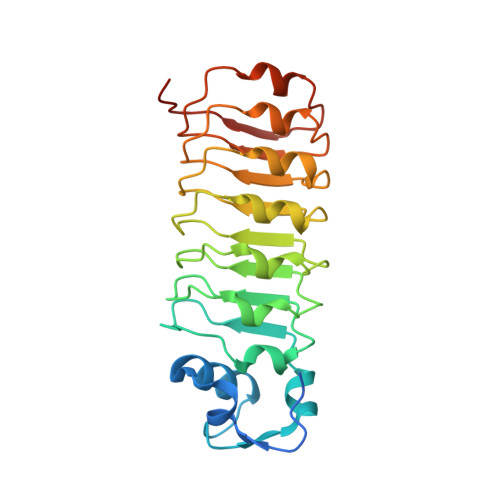Role of a noncanonical disulfide bond in the stability, affinity, and flexibility of a VHH specific for the Listeria virulence factor InlB.
Mendoza, M.N., Jian, M., King, M.T., Brooks, C.L.(2020) Protein Sci 29: 1004-1017
- PubMed: 31981247
- DOI: https://doi.org/10.1002/pro.3831
- Primary Citation of Related Structures:
6U12, 6U14 - PubMed Abstract:
A distinguishing feature of camel (Camelus dromedarius) VHH domains are noncanonical disulfide bonds between CDR1 and CDR3. The disulfide bond may provide an evolutionary advantage, as one of the cysteines in the bond is germline encoded. It has been hypothesized that this additional disulfide bond may play a role in binding affinity by reducing the entropic penalty associated with immobilization of a long CDR3 loop upon antigen binding. To examine the role of a noncanonical disulfide bond on antigen binding and the biophysical properties of a VHH domain, we have used the VHH R303, which binds the Listeria virulence factor InlB as a model. Using site directed mutagenesis, we produced a double mutant of R303 (C33A/C102A) to remove the extra disulfide bond of the VHH R303. Antigen binding was not affected by loss of the disulfide bond, however the mutant VHH displayed reduced thermal stability (T m = 12°C lower than wild-type), and a loss of the ability to fold reversibly due to heat induced aggregation. X-ray structures of the mutant alone and in complex with InlB showed no major changes in the structure. B-factor analysis of the structures suggested that the loss of the disulfide bond elicited no major change on the flexibility of the CDR loops, and revealed no evidence of loop immobilization upon antigen binding. These results suggest that the noncanonical disulfide bond found in camel VHH may have evolved to stabilize the biophysical properties of the domain, rather than playing a significant role in antigen binding.
- Department of Chemistry, California State University Fresno, Fresno, California.
Organizational Affiliation:

















